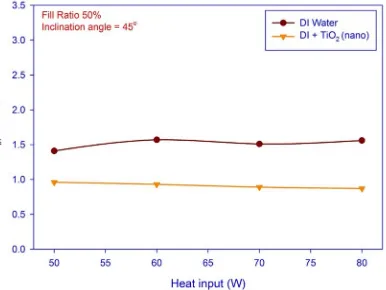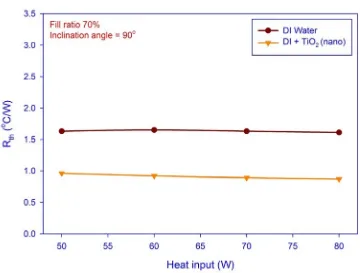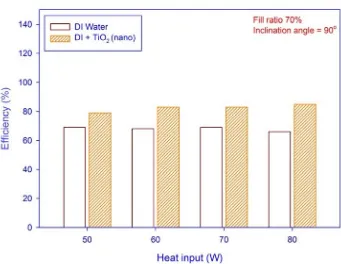http://www.sciencepublishinggroup.com/j/ajmie doi: 10.11648/j.ajmie.20180304.11
ISSN: 2575-6079 (Print); ISSN: 2575-6060 (Online)
Performance of TiO
2
Nanofluid and DI Water Filled Flat Type
Heat Pipe (FTHP) Internally Grooved at Various Fill Ratios
and Inclinations
Alagappan Narayanan, Karunakaran Narayanaswami, Gunabal Senthilnathan
Department of Mechanical Engineering, Annamalai University, Annamalainagar, India
Email address:
To cite this article:
Alagappan Narayanan, Karunakaran Narayanaswami, Gunabal Senthilnathan. Performance of TiO2 Nanofluid and DI Water Filled Flat Type
Heat Pipe (FTHP) Internally Grooved at Various Fill Ratios and Inclinations. American Journal of Mechanical and Industrial Engineering. Vol. 3, No. 4, 2018, pp. 39-46. doi: 10.11648/j.ajmie.20180304.11
Received: June 6, 2018; Accepted: July 3, 2018; Published: July 31, 2018
Abstract:
Heat pipe operates, with a metallic wick (or grooved) installed inside the pipe, containing fluid under a pressure which permits evaporated vapour at the hot side to fill the core of the pipe and travel to the cooled side. The vapour condenses at cold side, transporting heat by this method. This study focuses on the heat transfer performance of flat type internally grooved heat pipe with two different working fluids DI water and TiO2 nano fluid, used with various heat input (50, 60, 70 and80W) and at two different orientation 45deg and 90deg of the pipe. The fill ratio used was 50% and 70%, concentration and the size of the nano particle were 80 mg/lit and 30 nm respectively. In this setup, the condenser section of the Flat Type Heat Pipe (FTHP) was cooled by rectangular aluminum fins. The result shows that the decisive factors of FTHP are the working fluids, internal grooves and inclination angle. The relatively high rate of heat transfer was achieved while using TiO2 nano fluid at
90deg orientation with a fill ratio of 50% compared to FTHP with DI water.
Keywords:
FTHP, Internally Grooved, Rectangular Aluminum Fins, Fill Ratio1. Introduction
Heat pipes are very effective heat transfer devices employed to transmit large quantities of heat through a small cross-sectional area over a considerable distance with no additional power input to the system. They are also capable of controlling and transporting large quantities of heat at various temperature levels. They were first conceptualized in 1836 by Jocob perkins and was called the perkins tube. Heat pipes have been used in space crafts, computers, solar systems, heat and ventilating air – conditioning systems and many other applications [1].
The majority of research presented in the heat pipe are addresses a cylindrical shaped geometry [2, 3, 4-13]. However, it has been clearly demonstrated that the flat-shaped heat pipes [13-18] have an advantage in terms of heat removal capability and geometrical adaption for many applications such as electronic cooling, space craft thermal control and commercial thermal applications.
Nanofluids possess unique properties, which motivate
40 Alagappan Narayanan et al.: Performance of TiO2 Nanofluid and DI Water Filled Flat Type Heat Pipe (FTHP)
Internally Grooved at Various Fill Ratios and Inclinations
gives better heat transfer performance. Providing the internal fins at the condenser produces additional condensation which improves the thermal performance by 17%. Baskar et al [25] studied the enhancement of convective heat transfer of secondary refrigerant. The study indentified that CNT nano fluid enhances the convective heat transfer of secondary refrigerant and also improves the efficiency of the experimental setup.
Not much work was found in the literature using FTHP with rectangular fins. From the literature review it could be concluded that the performance of a heat pipe depended upon types of fill liquid, fill ratio and power input. This is due to the very complex nature of the boiling process in the heat pipe. As a result, the thermal resistance and efficiency of the heat pipe would be affected. The objective of this paper is to
determine the effect of thermal resistance and the fin efficiency of DI water and TiO2 nature fluid at two fill ratios
and two different orientations of FTHP.
2. Experimental Setup
The schematic diagram of the experimental setup is shown in Figure 1. The first priority goes to the material selection of FTHP. The material has to be selected in such a way that it can permit a wide range of temperature and it should have better heat transfer characteristics. The copper pipes are more effective. For a heat pipe operating below 200°C. The cut-section of FTHP internally grooved show in Figure 2. All the other parameters are given in Table 1.
Figure 1. Experimental setup.
Figure 2. Cut-Section of Flat Type Heat Pipe Internally Grooved.
Table 1. FTHP experimental configuration.
Total Length of FTHP 600 mm
Evaporator length 200 mm
Adiabatic length 200 mm
Condenser length 200 mm
Fins material ALUMINUM
No. of rectangular fins 34
Breadth of the pipe 12
Thickness of the pipe 10 mm
Fill ratio 50% & 70%
Inclination angle 45° & 90°
FTHP Internally grooved
The temperature distribution of flat heat pipe at wall was measured with K-type thermocouple. In total eight thermocouples on the heat pipe wall ie., two at evaporator, two at adiabatic and four at condensation section. The uncertainty in temperature measured was ± 0.1°C all these thermocouples were connected to the temperature indicator.
Plate type heater (max. 200 W) was used as a heat source in the evaporator section. The heat input was measured by using watt meter. The power is varied with the help of an auto transformer, the condenser section was surrounded by rectangular aluminium fins and it was cooled by atmospheric air (free convection).
Spherical TiO2 nanoparticles with 30 nm diameter are
utilized and DI water was used as the base fluid to prepare the nanofluid and the concentration of 80 mg/lit nanoparticles are dispersed in the deionized water and the solution is vibrated in an ultrasonic device for 9 hrs in order to obtained a uniformly dispersed solution. The mixture was created by using an ultrasonic homogenizer. Figure 3 shows a SEM image of TiO2 nano particles. The experimental samples have
Figure 3. A SEM Photograph of TiO2 nanoparticles.
Thermal resistance is expressed as the ratio of temperature difference to input heat provided at the evaporator as given by equation (1),
evap condenser
∆
(1)
The amount of heat transfer to the thermosyphon is calculated from the formula given below,
(2)
Fin Efficiency (Steady state analysis) are calculated from the formula given below,
2
∆
(3)
! "#$ (4)
For rectangular fin %& % '
( )%&
%& %
From HMT data book the efficiency of the rectangular fin is calculated.
3. Results and Discussions
3.1. Effect of Fill Ratio
Figure 4-7 represents the fill ratio profile related to tilt angle, working fluid, heat input and thermal resistance. Conveniently, influence of percentage charged value of working fluid on the thermal performance of FTHP internally grooved. The high range [300 to 7000 Btu/hr-ft2°F] of heat transfer was achieved in the evaporator section by using internally grooved heat pipe was reported by Carnavos [26]. In order to study the effect of% charged value of working fluid on thermal resistance of FTHP, in a different heat input, here heat pipe was charged with two different working fluids were DI water and TiO2 nano fluid in two different quantities
50% and 70% of fill ratio. From graph, that thermal resistance decreases when charged value is 50% for TiO2
42 Alagappan Narayanan et al.: Performance of TiO2 Nanofluid and DI Water Filled Flat Type Heat Pipe (FTHP)
Internally Grooved at Various Fill Ratios and Inclinations
Figure 4. Rth Vs heat input fill ratio 50% inclination angle 45°.
Figure 6. Rth Vs heat input fill ration 70% inclination angle 45°.
Figure 7. Rth Vs heat input fill ratio 70% inclination angle 90°.
3.2. Efficiency of Fin
In order to obtain the high efficiency, the experiment is designed with the condenser section was surrounded by 34 number of rectangular fins, from Figure 8-11it is clear there is a drastic change in efficiency when filled with 70% of working fluid. This due to the formation of thin liquid film
inside the condenser section. Whereas 50% of charge value of the working fluid exhibits high efficiency in all heat inputs in both the orientation of FTHP (45° and 90° because of strong positive influence of capillary action (internal groove). The maximum efficiency (87%) was achieved at 50% of charge value of the TiO2 nano fluid in the orientation of 90°.
44 Alagappan Narayanan et al.: Performance of TiO2 Nanofluid and DI Water Filled Flat Type Heat Pipe (FTHP)
Internally Grooved at Various Fill Ratios and Inclinations
Figure 8. Efficiency Vs heat input fill ratio 50% inclination angle 45°.
Figure 10. Efficiency Vs heat input fill ratio 70% inclination angle 45°.
Figure 11. Efficiency Vs heat input fill ratio 70% inclination angle 90°.
4. Conclusion
This articles deals with the thermal enhancement of the grooved FTHP performance by charging 50% and 70% of DI water and TiO2 nanofluid as the working fluids which is
experimentally tested with two orientations were 45° and 90°. Tilt angle had a strong effect on thermal performance of FTHP such that when tilt angle increases, due to the strong influence of gravitational force on the flowing of working
fluid, particularly on the nanoparticles, the FTHP of rectangular fin efficiency increases. FTHP resistance increased with increasing fill ratio. The TiO2 nano fluid filled
FTHP performed better in the 90° orientation at both the fill ratios (50% and 70%). Both the the resistance and efficiency was drastically changed in case of DI water shows higher values of resistance and low efficiency in all cases. Results indicate that the TiO2 nano fluid has remarkable potential as a
46 Alagappan Narayanan et al.: Performance of TiO2 Nanofluid and DI Water Filled Flat Type Heat Pipe (FTHP)
Internally Grooved at Various Fill Ratios and Inclinations
Nomenclature
TiO2 Titanium di oxide
CNT Carbon nano tubes
FTHP Flat type heat pipe
mLHP Miniature loop heat pipe
RSM Response surface methodology
DI Di ionized
SEM Scanning electron microscope
V Voltage, volts
I Current, amps
Rth Thermal resistance, °C/W
Qin Heat input, W
Tavg (evap)
Arithmetic mean temperature in evaporator section, °C
Tavg (condenser)
Arithmetic mean temperature in condenser section, °C
Gr Grashof number
Nu Nusselt number
Tatm Atmospheric temperature, °C
Tfin avg Arithmetic mean temperature in fins, °C
References
[1] Faghri, A. Heat Pipe Science and Technology, Taylor -0Francis, 1995.
[2] Shafahi, M., Bianco, V., Vafai, K., and Manca, O. An Investigation of The Thermal Performance of Cylindrical Heat Pipes using Nanofluids, Int. J. Heat Mass Transfer 53 (1–3) (2010) 376–383.
[3] Zhu, N. and Vafai, K. Analysis of Cylindrical Heat Pipes Incorporating The Effects of Liquid–Vapor Coupling and Non-Darcian Transport – A Closed Form Solution, Int. J. Heat Mass Transfer 42 (18) (1999) 3405–3418.
[4] Kang, S. W., Wei, W. C. Tsai, S. H. and Yang, S. Y. Experimental Investigation of Silver Nano-Fluid on Heat Pipe Thermal Performance, Appl. Thermal Eng. 26 (17–18) (2006) 2377–2382.
[5] Kang, S. W., Wei, W. C., and Tsai, C. C. Huang, Experimental Investigation of Nanofluids on Sintered Heat Pipe Thermal Performance, Appl. Thermal Eng. 29 (5–6) (2009) 973–979. [6] Lin, Y. H., Kang, S. W. and Chen, H. L. Effect of Silver
Nano-Fluid on Pulsating Heat Pipe Thermal Performance, Appl. Therm. Eng. 28 (11–12) (2008) 1312–1317.
[7] Ma, H. B. Wilson, C., Borgmeyer, B., Park, K., Yu, Q., Choi, S. U. S. and Tirumala, M. Effect of Nanofluid on The Heat Transport Capability in an Oscillating Heat Pipe, Appl. Phys. Lett. 88 (14) (2006) 143113–143116.
[8] Ma, H. B., Wilson, C., Yu, Q., Park, K. and Choi, M. Tirumala, An Experimental Investigation of Heat Transport Capability in a Nanofluid Oscillating Heat Pipe, J. Heat Transfer 128 (11) (2006) 1213–1216.
[9] Naphon, P. Assadamongkol, P. and Borirak, T, Experimental Investigation of Titanium Nanofluids on The Heat Pipe Thermal Efficiency, Int. Commun. Heat Mass 35 (10) (2008) 1316–1319.
[10] Naphon, P., Thongkum, D. and Assadamongkol, P, Heat Pipe
Efficiency Enhancement with Refrigerant–Nanoparticles Mixtures, Energy Convers. Manage. 50 (3) (2009) 772–776. [11] Tournier, J. M. and El-Genk, M. S, A Heat Pipe Transient
Analysis Model, Int. J. Heat Mass Transfer 37 (5) (1994) 753– 762.
[12] Tsai, C. Y., Chien, H. T., Ding, P. P., Chan, B., Luh, T. Y. and Chen, P. H, Effect of Structural Character of Gold Nanoparticles in Nanofluid on Heat Pipe Thermal Performance, Mater. Lett. 58 (9) (2004) 1461–1465.
[13] Shafahi, M., Bianco, V., Vafai, K. and Manca, O, Thermal Performance of Flat-Shaped Heat Pipes using Nanofluids, Int. J. Heat Mass Transfer 53 (7–8) (2010) 1438– 1445.
[14] Vafai, K. and Wang, W, Analysis of Flow and Heat Transfer Characteristics of an Asymmetrical Flat Plate Heat Pipe, Int. J. Heat Mass Transfer 35 (9) (1992) 2087–2099.
[15] Vafai, K., Zhu, N. and Wang, W, Analysis of Asymmetric Disk-Shaped and Flat-Plate Heat Pipes, J. Heat Transfer 117 (1) (1995) 209–218.
[16] Wang, Y. amd Vafai, K, Transient Characterization of Flat Plate Heat Pipes During Startup and Shutdown Operations, Int. J. Heat Mass Transfer 43 (15) (2000) 2641–2655.
[17] Wang, Y. and Vafai. K, an Experimental Investigation of the Thermal Performance of an Asymmetrical Flat Plate Heat Pipe, Int. J. Heat Mass Transfer 43 (15) (2000) 2657–2668. [18] Wang, Y. and Vafai, K, an Experimental Investigation of the
Transient Characteristics on a Flat-Plate Heat Pipe During Startup and Shutdown Operations, J. Heat Transfer 122 (3) (2000) 525–535.
[19] Wenhua, Y., France, D. M., Routbort, J. L. and Choi, S. U. S. Review and Comparison of Nanofluid Thermal Conductivity and Heat Transfer Enhancements, Heat Transfer Eng. 29 (5) (2008) 432–460.
[20] Das, S. K., Choi, S. U. S. and Patel, H. E, Heat Transfer in Nanofluids: A Review, Heat Transfer Eng. 27 (2006) 3–19. [21] Kakac, S. and Pramuanjaroenkij, A, Review of Convective
Heat Transfer Enhancement with Nanofluids, Int. J. Heat Mass Transfer 52 (2009) 3187–3196.
[22] Buschmann, M. H, Nanofluids in Thermosyphons and Heat Pipes: Overview of Recent Experiments and Modelling Approaches, Int. J. Therm. Sci. 72 (2013) 1– 17.
[23] Trijo Tharayil, Lazarus Godson Asirvatham, Micheal Jerome Dau, Somachai Wongwises, Entropy Generation Analysis of Miniature Loop Heat Pipe with Graphene-Water Nanofluid: Thermodynamics Model and Experimental Study, Int. J. Heat and Mass Transfer, 106 (2017) 407-421.
[24] Y. Naresh, C. Balaji, Experimental Investigations of Heat Transfer from an Internally Finned Two-Phase Closed Thermosyphon, Applied Thermal Engg, 112 (2017) 1658-1666. [25] S. Baskar, M. Chandrasekaran, J. Vinod kumar, P. Vivek and
L. Karikalan, Experimental Studies on Convective Heat Transfer Co-Efficient of Water/Ethylene Glycol Carbon Nano Tube Nano Fluids, International Journal of Ambient Energy, ISSN: 0413-0750, 2018.





